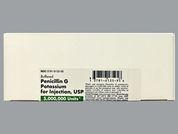Penicillin G Potassium
Penicillin G Potassium
What is Penicillin G Potassium used for?
This medication is used to treat a wide variety of bacterial infections. It is also used to prevent infection of the heart (bacterial endocarditis) in patients with certain heart diseases who are having surgery. This medication is known as a natural penicillin antibiotic. It works by stopping the growth of bacteria.
CHEMICAL NAME
DRUG TYPE
Penicillin G Potassium Prices
Searching for the lowest prices
What does Penicillin G Potassium look like?
View all Penicillin G Potassium Image Information (4)Penicillin G Potassium Frequently Asked Questions
Pain/redness/swelling at injection site may occur. If any of these effects last or get worse, tell your doctor or pharmacist promptly.
Remember that this medication has been prescribed because your doctor has judged that the benefit to you is greater than the risk of side effects. Many people using this medication do not have serious side effects.
Tell your doctor right away if you have any serious side effects, including: joint/muscle pain, muscle weakness, swelling of ankles/feet, dark/cloudy urine, extreme tiredness, fast/slow/irregular heartbeat, new signs of infection (such as sore throat that doesn't go away, fever), easy bruising/bleeding, signs of kidney problems (such as change in the amount of urine), numbness/tingling of arms/legs, seizures, uncontrolled movements, confusion.
If used to treat syphilis or other spirochetal infections (such as Lyme disease), this medication may cause a condition known as Jarisch-Herxheimer reaction. This condition may occur 1 to 2 hours after you receive the medication and can last up to 24 hours. Notify your doctor right away if you experience any of these symptoms: fever/chills, muscle pain, worsening of skin sores, fast heartbeat, fast breathing, dizziness, flushing.
This medication may rarely cause a severe intestinal condition due to a bacteria called C. difficile. This condition may occur during treatment or weeks to months after treatment has stopped. Tell your doctor right away if you develop: diarrhea that doesn't stop, abdominal or stomach pain/cramping, blood/mucus in your stool.
If you have these symptoms, do not use anti-diarrhea or opioid products because they may make symptoms worse.
Use of this medication for prolonged or repeated periods may result in oral thrush or a new vaginal yeast infection. Contact your doctor if you notice white patches in your mouth, a change in vaginal discharge, or other new symptoms.
A very serious allergic reaction to this drug is rare. However, get medical help right away if you notice any symptoms of a serious allergic reaction, including: rash, itching/swelling (especially of the face/tongue/throat), severe dizziness, trouble breathing.
This is not a complete list of possible side effects. If you notice other effects not listed above, contact your doctor or pharmacist.
In the US -
Call your doctor for medical advice about side effects. You may report side effects to FDA at 1-800-FDA-1088 or at MedWatch: The FDA Safety Information and Adverse Event Reporting Program.
In Canada - Call your doctor for medical advice about side effects. You may report side effects to Health Canada at 1-866-234-2345.
IMPORTANT: HOW TO USE THIS INFORMATION: This is a summary and does NOT have all possible information about this product. This information does not assure that this product is safe, effective, or appropriate for you. This information is not individual medical advice and does not substitute for the advice of your health care professional. Always ask your health care professional for complete information about this product and your specific health needs.



